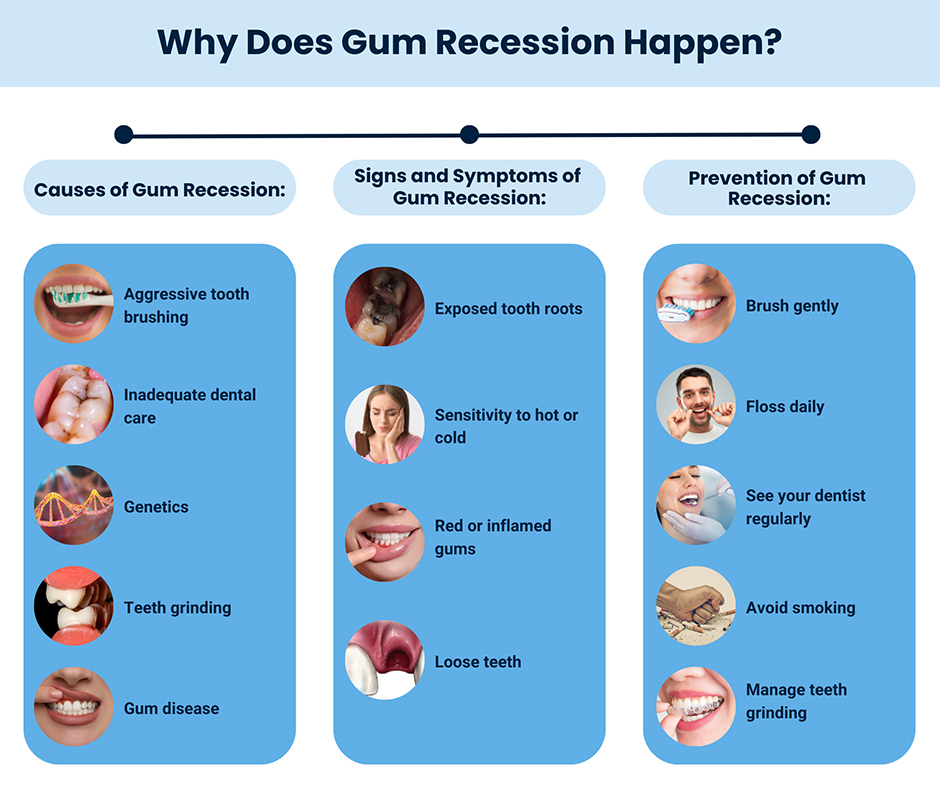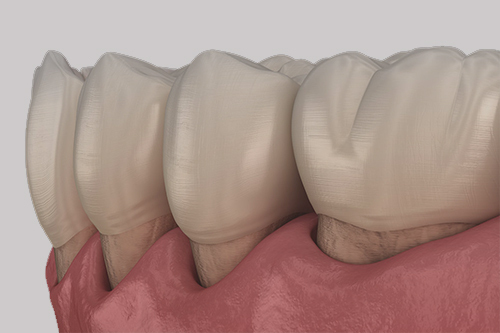Gum recession occurs when the gums wear away and get pulled back exposing the teeth or the tooth root. This process causes gaps between the gums and the teeth where bacteria can get trapped and grow. Over time, gum recession can cause the tissues and the teeth to get severely infected, resulting in tooth loss.
Most people don’t even know they have receding gums because it happens gradually. You may notice symptoms such as tooth sensitivity or your tooth looking a little bit longer than before.
If you suspect you have gum recession you should see a leading gum recession specialist immediately at our Brooklyn dental clinic and discuss gum surgery.
Why Does Gum Recession Happen?
Gum recession happens when cells begin to decrease in volume, eat themselves up along with their structural components and organelles. This happens when your gum cells attempt to survive in a hostile environment. It is estimated that 23% of adults in the US have one or more tooth surfaces with gum recession. However, 88% of older adults have at least one tooth with gum recession.
Some reasons for gum recession include:
- Aggressive tooth brushing: If you brush your teeth too hard this can cause the enamel on your teeth to wear down and your gums to recceed.
- Inadequate dental care: Not brushing and flossing regularly can lead to plaque turning into calculus, which can eat away at your teeth and gums causing them to recede.
- Genes: Sometimes gum recession is genetic and is not affected by how well you take care of your teeth.
- Grinding your teeth: Grinding or clenching your teeth can create too much pressure and cause your gums to recceed.
- Gum disease: The main cause of gum recession is the bacteria that grows in your mouth when you have gum disease.
Regardless of the cause of gum recession, you should seek treatment immediately. If left untreated gum recession can lead to tooth damage and possibly tooth loss.

Is Gum Recession Reversible?

The procedure involves folding back the infected gum tissue and cleaning out the bacteria. If the bone supporting the tooth has been destroyed, after the cleaning, dental surgeon skillfully applies a regenerative material to encourage bone to grow back. After this, your gum grafting dentist will choose a donor tissue, either from your own body or somewhere else, to replace over the receded gums.
There are different types of gum recession surgery. You and your gum recession surgeon will decide which type is best for your individual needs.
When to Get a Gum Graft?
If you are not sure if you have receding gums but have tooth sensitivity, tooth pain, or your tooth seems longer than before contact leading gum graft dentist Dr. Drekhtyar to get a consultation about whether you need gum surgery. Sometimes a physical examination can be enough to diagnose gum recession.
If further examination is needed Dr. Drekhtyar uses the latest World Health Organisation (WHO) Community Periodontal Index (CPI) probe to assign a recession score to each tooth. For more severe cases of periodontitis, your gum grafting doctor also has computerized periodontal probes to assess disease progression.
Gum Graft Recovery
After your gum grafting, your gum grafting dentist will prescribe you antibiotics as a preventative measure to avoid infection. Your dentist in NYC will also give you a stent to protect your palate, minimize bleeding, and speed up the recovery process.
You can take over the counter medication for the pain in your mouth. The pain should not be too severe, some describe it as a hot food burn in your mouth. If you are concerned about your level of pain, contact your gum recession specialist.
You may initially have to be on a liquid diet. After a few days, when you feel ready, you may be able to start eating soft foods.
Take it easy and rest for the first week. Giving your body time to heal will speed up your recovery. Most importantly, take care of you teeth by brushing and flossing regularly after your gum surgery.
Gum Graft Cost
There are different types of gum graft surgery and your gum surgery cost will depend on the type you and your gum recession specialist decide on. The earlier you see a gum graft specialist will also determine the complexity of the surgery, and therefore the cost.
Insurance usually covers most of the cost of gum graft.
If you have any questions about gum grafting or would like to schedule an appointment with leading gum surgeon Dr. Drekhtyar, please do not hesitate to call our Bushwick, Brooklyn dental clinic.

Dr. Ella Dekhtyar is an ABGD-certified cosmetic and family dentist who strives to provide the best and most appropriate dental care using the latest cutting-edge technology and treatment. Dr. Dekhtyar has more than 20 years of experience creating beautiful and healthy smiles, backed by receiving multiple awards, including America’s Best Dentist and New York Magazine Best Dentists in 2010 & 2012, and her collaboration with prominent media outlets.
Recognized as one of the most highly regarded dentists in the Bushwick and Bedford-Stuyvesant community, Dr. Dekhtyar operates in several languages, including English, Spanish, as well as Russian, and provides highly praised aesthetic and functional results in a welcoming and relaxing environment.
More about Dr. Dekhtyar